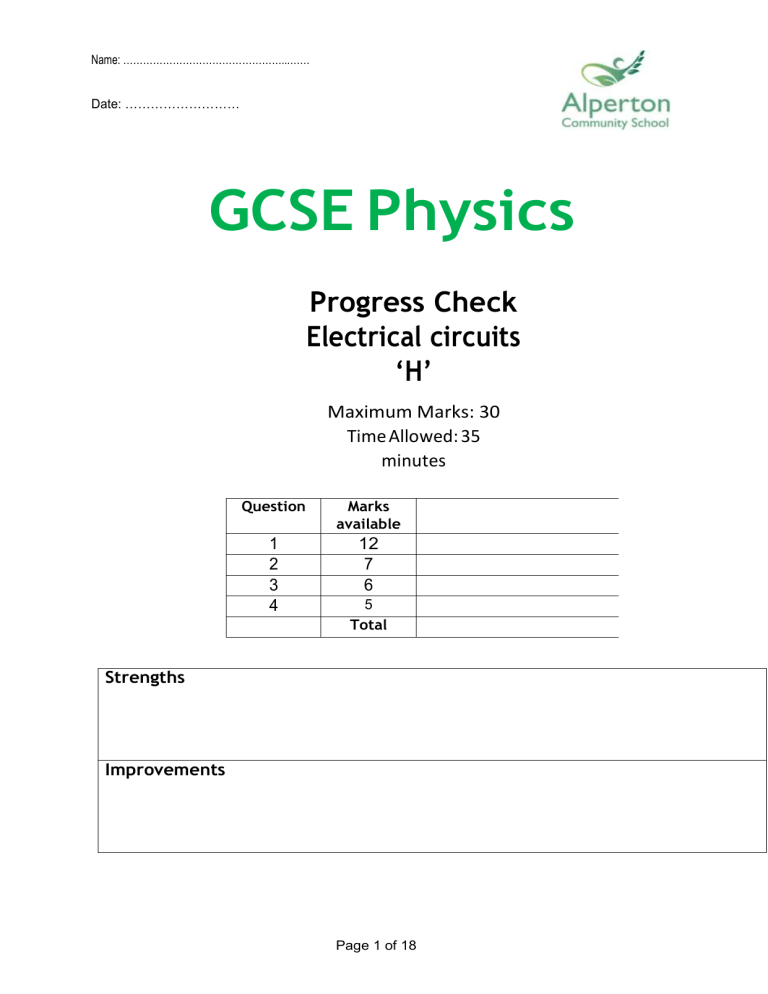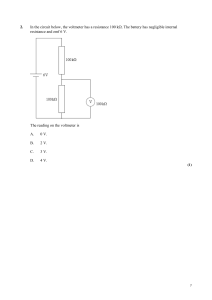
Name: …………………………………………...…… Date: ……………………… GCSE Physics Progress Check Electrical circuits ‘H’ Maximum Marks: 30 Time Allowed: 35 minutes Question Marks available 1 2 3 4 12 7 6 5 Total Strengths Improvements Page 1 of 18 Response Page 2 of 18 Q1. (a) Complete the sentence below to name the instrument used to measure electrical current. The instrument used to measure electrical current is called ___________________ (1) (b) In the diagram below each box contains an electrical component or a circuit symbol. Draw straight lines to link each electrical component to its circuit symbol. The first one has been done for you. (4) (Total 5 marks) Page 3 of 18 Q2. Components can be connected in electrical circuits in different ways. (a) Draw one line from each circuit symbol to the name of the component it represents. Circuit symbol Name of component cell diode fuse lamp variable resistor (2) (b) Complete the sentence. Choose the answer from the box. charge energy potential difference resistance Electric current is the rate of flow of ____________________. (1) Figure 1 shows a parallel circuit. Figure 1 Page 4 of 18 (c) Calculate the current measured by ammeter A2. Current = ____________________ A (1) (d) The circuit is connected for 300 s The total current in the circuit stays at 0.56 A Calculate the total charge flow. Use the equation: charge flow = current × time ___________________________________________________________________ ___________________________________________________________________ ___________________________________________________________________ ___________________________________________________________________ Charge flow = ____________________ C (2) (e) The potential difference supplied by the battery is 4.5 V Calculate the total energy transferred in 300 s Use the equation: energy transferred = charge flow × potential difference Use your answer to part (d). ___________________________________________________________________ ___________________________________________________________________ ___________________________________________________________________ ___________________________________________________________________ Energy transferred = ____________________ J (2) (f) Figure 2 shows a series circuit. Figure 2 Page 5 of 18 Resistor R2 breaks. What happens to the reading on the ammeter? ___________________________________________________________________ (1) (g) Figure 3 shows a parallel circuit. Figure 3 Resistor R3 breaks. What happens to the readings on the ammeter? Ammeter A1 _________________________________________________________ Ammeter A2 _________________________________________________________ (2) Page 6 of 18 Figure 4 shows how the resistance of a component varies with temperature. Figure 4 Page 7 of 18 (h) What is the name of the component? Tick one box. LED LDR Resistor Thermistor (1) (i) What is the resistance of the component at a temperature of 50 °C? Resistance = ____________________ Ω (1) (Total 13 marks) Q3. (a) Draw one line from each circuit symbol to its correct name. Circuit symbol Name Diode Light-dependent resistor (LDR) Lamp Light-emitting diode (LED) (3) (b) Figure 1 shows three circuits. The resistors in the circuits are identical. Page 8 of 18 Each of the cells has a potential difference of 1.5 volts. Figure 1 Circuit 1 (i) Circuit 2 Circuit 3 Use the correct answer from the box to complete the sentence. half twice the same as The resistance of circuit 1 is _________________ the resistance of circuit 3. (1) (ii) Calculate the reading on voltmeter V2. ______________________________________________________________ Voltmeter reading V2 = _______________ V (1) (iii) Which voltmeter, V1, V2 or V3, will give the lowest reading? Draw a ring around the correct answer. V1 V2 V3 (1) (c) A student wanted to find out how the number of resistors affects the current in a series circuit. Figure 2 shows the circuit used by the student. Figure 2 The student started with one resistor and then added more identical resistors to the circuit. Each time a resistor was added, the student closed the switch and took the ammeter Page 9 of 18 reading. The student used a total of 4 resistors. Figure 3 shows three of the results obtained by the student. Figure 3 Number of resistors in series (i) To get valid results, the student kept one variable the same throughout the experiment. Which variable did the student keep the same? ______________________________________________________________ (1) (ii) The bar chart in Figure 3 is not complete. The result using 4 resistors is not shown. Complete the bar chart to show the current in the circuit when 4 resistors were used. (2) (iii) What conclusion should the student make from the bar chart? ______________________________________________________________ ______________________________________________________________ (1) (Total 10 marks) Q4. Figure 1 shows a circuit diagram containing two identical lamps arranged in parallel. The reading on the ammeter is 186 mA. Page 10 of 18 Figure 1 (a) Which statement about the current through the lamps is true? Tick one box. The current through both lamp P and lamp Q is 0.093 A The current through both lamp P and lamp Q is 0.186 A The current through both lamp P and lamp Q is 0.93 A The current through both lamp P and lamp Q is 1.86 A (1) (b) One of the lamps breaks and is not replaced. Which statement about the current in the other lamp is true? Tick one box. The current through the lamp is 0.093 A The current through the lamp is 0.186 A The current through the lamp is 0.93 A The current through the lamp is 1.86 A (1) (c) Figure 2 shows a circuit that can be used to alter the brightness of a lamp. Figure 2 Page 11 of 18 The resistance of the variable resistor is increased. What effect will this have on the brightness of the lamp? Explain your answer. ___________________________________________________________________ ___________________________________________________________________ ___________________________________________________________________ ___________________________________________________________________ (2) (d) When the potential difference across the lamp is 3.3 V, the current is 0.15 A. Write down the equation that links current, potential difference and resistance. Equation ___________________________________________________________ (1) (e) Calculate the resistance of the lamp. ___________________________________________________________________ ___________________________________________________________________ ___________________________________________________________________ Resistance = __________________ Ω (3) (f) Sketch a current–potential difference graph for a filament lamp. Page 12 of 18 (1) (Total 9 marks) Q5. (a) The diagram shows the voltage-current graphs for three different electrical components. Which one of the components A, B or C could be a 3 volt filament lamp? Explain the reason for your choice. ___________________________________________________________________ ___________________________________________________________________ ___________________________________________________________________ ___________________________________________________________________ (3) (b) Using the correct symbols draw a circuit diagram to show how a battery, ammeter and voltmeter can be used to find the resistance of the wire shown. Page 13 of 18 (3) (c) When correctly connected to a 9 volt battery the wire has a current of 0.30 amperes flowing through it. (i) Give the equation that links current, resistance and voltage. ______________________________________________________________ (1) (ii) Calculate the resistance of the wire. Show clearly how you work out your answer and give the unit. ______________________________________________________________ ______________________________________________________________ Resistance = _____________________________ (3) (iii) When the wire is heated, the current goes down to 0.26 amperes. State how the resistance of the wire has changed. ______________________________________________________________ ______________________________________________________________ (1) (Total 11 marks) Page 14 of 18 Mark schemes Q1. (a) ... ammeter for 1 mark 1 (b) 5 right gains 4 marks 4 right gains 3 marks 3 right gains 2 marks 2 right gains 1 mark 4 [5] Q2. (a) extra lines from circuit symbols negate the mark 1 1 (b) charge 1 (c) 0.13 (A) 1 (d) 0.56 × 300 1 168 (C) an answer of 168 (C) scores 2 marks 1 (e) 168 × 4.5 1 756 (J) an answer of 756 (J) scores 2 marks allow ecf from part (d) 1 Page 15 of 18 (f) decreases to zero allow reads zero 1 (g) (A1) decreases to zero allow reads zero 1 (A2) decreases do not accept ‘to zero’ for A2 1 (h) thermistor 1 (i) answer in range 160–165 (Ω) 1 [13] Q3. (a) allow 1 mark for each correct line if more than one line is drawn from any symbol then all of those lines are wrong 3 (b) (i) half 1 (ii) 3(V) 1 (iii) V1 1 (c) (i) potential difference / voltage of the power supply accept the power supply accept the voltage / volts accept number of cells / batteries accept (same) cells / batteries do not accept same ammeter / switch / wires 1 Page 16 of 18 (ii) bar drawn – height 1.(00)A ignore width of bar allow 1 mark for bar shorter than 3rd bar 2 (iii) as the number of resistors increases the current decreases 1 [10] Q4. (a) 0.093 A 1 (b) 0.093 A 1 (c) (increasing the resistance) decreases the current 1 therefore (the lamp will be) dimmer 1 (d) potential difference = current × resistance accept correct rearrangement with R as subject 1 (e) 3.3 = 0.15 × R 1 R = 3.3 / 0.15 (Ω) 1 R = 22 (Ω) 1 allow 22 (Ω) without working shown for 3 marks (f) line drawn from the origin with a decreasing gradient. 1 [9] Q5. (a) C award mark if A and B identified as not filament lamp 1 resistance increases negated by wrong statement e.g. current goes down 1 as the lamp gets hot accept as current (through lamp) or voltage (across lamp) increases do not accept non-ohmic reason independent of choice of component 1 Page 17 of 18 (b) ammeter wire and battery only in series non standard symbols acceptable if correctly identified (labelled) for ammeter, voltmeter and battery 1 voltmeter only in parallel with wire or battery all in series or ammeter in parallel neither of these two marks awarded 1 all symbols correct ignore lines drawn through centres of symbols 1 (c) (i) voltage = current × resistance accept V = I × R accept volts = amps × ohms do not accept V = C × R accept if subsequent method correct 1 (ii) 30 accept correct substitution for 1 mark (9/0.3) 2 ohms accept correct symbol Ω 1 (iii) goes up must be a comparison accept calculation if answer is larger than c (ii) 1 [11] Page 18 of 18






